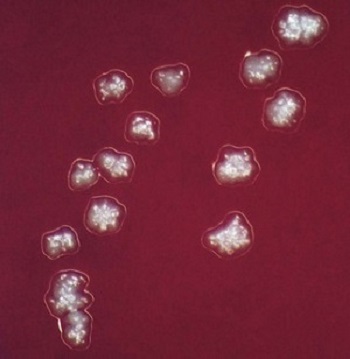Actinomyces - Classification, Morphology, Colony, Characteristics, Medically important species, Infections
Classification of Actinomyces
Domain: Bacteria
Phylum: Actinomycetota
Class: Actinomycetia
Order: Actinomycetales
Family: Actinomycetaceae
Genus: Actinomyces
Morphology of Actinomyces
Actinomyces are gram-positive, non-motile, non-spore-forming, non-acid fast filamentous bacteria measuring about 0.5-1µm. They often grow in filaments- separated into bacilli and coccoid filaments. Its natural habitat includes soil, water, sediment, plant surface, humans, and animals.
Colony characteristics of Actinomyces
Actinomyces micro-organisms are facultative anaerobes and grow in 5-10% CO2. The optimum temperature is 35-37°C and the incubation period (IP) is around 3-4 days while for Actinomyces israelii the incubation time is 7-14 days.
For growth in vitro, it requires BHI (Brain Heart Infusion) added to 5% defibrinated rabbit sheep or horse blood. The colonies have a molar teeth appearance and are catalase positive.

Fig: Actinomyces israelii colony on BA (Source: pocketdentistry)
Cell Wall Components of Actinomyces
The Actinomyces bacterial cell wall contains muramic acid, 70s ribosome, and is susceptible to host antibodies.
In some species, cell walls contain mycolic acid such as Nocardia (acid-fast) while some are without mycolic acid including Streptomyces, Nocardiopsis, Actinomadura, Themoactinomyces, etc. All are aerobic except Actinomyces, which are facultative anaerobes.
Medically important species of Actinomyces
Disease-causing/medically important species include:
Actinomyces israleii (common)
Actinomyces turnisensis
Actinomyces odontolytics
Actinomyces meyeri
Actinomyces europaeus
Actinomyces bovis (in cattle)
Infections of Actinomyces
Actinomyces also cause chronic infectious debilitating disease in cattle mainly by A. bovis which is characterized by rarefying periostitis and the formation of body cavities filled with pus in head bones, particularly in the mandible and maxilla.
A. bovis actually are inhabitants of the mouth and digestive tract. Actinomyces grow in branching filaments (from sulfur granules of pus or tissue, coccoid or filament rods).
Some characteristics of the Actinomyces bacteria include:
difficulty in cultivation and requires serum or blood at 37°C
Infection predisposed by a wound to buccal mucosa by sharp pieces while trying to feed; Also can be caused by dental alveoli
pus is the source of infection
Actinomycosis (lumpy jaw jaundice) is caused by Actinomyces spp.